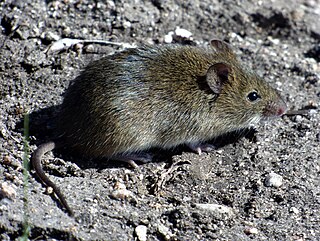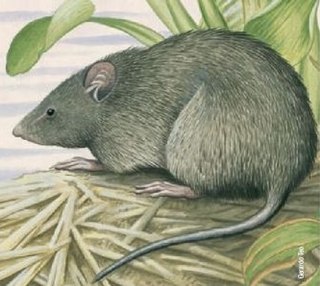
Akodon is a genus consisting of South American grass mice. They mostly occur south of the Amazon Basin and along the Andes north to Venezuela, but are absent from much of the basin itself, the far south of the continent, and the lowlands west of the Andes. Akodon is one of the most species-rich genera of Neotropical rodents. Species of Akodon are known to inhabit a variety of habitats from tropical and tropical moist forests to altiplano and desert. Fossils are known from the late Pliocene onwards.
The Serra do Mar grass mouse or Cerrado grass mouse is a rodent species from South America. It is found in Brazil.

Oligoryzomys flavescens, also known as the flavescent colilargo or yellow pygmy rice rat is a species of rodent in the genus Oligoryzomys of family Cricetidae. It is found in southern South America, occurring in southern Brazil, Paraguay, Uruguay, and northeastern Argentina. Its karyotype has 2n = 64-66 and FNa = 66–70.
Brucepattersonius griserufescens, also known as the gray-bellied akodont or grey-bellied brucie, is a rodent in the cricetid genus Brucepattersonius from southeastern Brazil, specifically the states of Minas Gerais, Espírito Santo and Rio de Janeiro between 1,300 and 2,700 metres. It was one of four species of Brucepattersonius described by Hershkovitz in 1998; another, Brucepattersonius albinasus, also known as the white-nosed akodont or white-nosed brucie, was later argued to be the same as B. griserufescens, though further work is needed to confirm this. It is threatened by habitat loss but is also protected by Caparaó National Park.
The lesser Wilfred's mouse is a species of South American rodents of the family Cricetidae. It was first described by Wilfred H. Osgood under the name Thomasomys pictipes, then into the genus Wilfredomys, and now known as Juliomys pictipes. The lesser Wilfred's mouse is endemic to northeastern Argentina and southeastern Brazil. Its physical appearance ranges from dark brown to light orange coloration and the typical size is small to medium. This species is arboreal, spending most of its time trees and living in the local forests at altitudes from sea level to 2000 m. Currently, this species is listed as Least Concern by the IUCN, but, threats include livestock farming, ranching, and wood harvesting.

Lundomys molitor, also known as Lund's amphibious rat or the greater marsh rat, is a semiaquatic rat species from southeastern South America.

Akodon spegazzinii, also known as Spegazzini's akodont or Spegazzini's grass mouse, is a rodent in the genus Akodon found in northwestern Argentina. It occurs in grassland and forest at 400 to 3,500 m above sea level. After the species was first named in 1897, several other names were given to various populations now included in A. spegazzinii. They are now all recognized as part of a single, widespread and variable species. Akodon spegazzinii is related to Akodon boliviensis and other members of the A. boliviensis species group. It reproduces year-round. Because it is widely distributed and common, Akodon spegazzinii is listed as "least concern" on the IUCN Red List.

Abrothrix is a genus of rodent in the tribe Abrotrichini of family Cricetidae. It contains the following living species:

The Patagonian chinchilla mouse is a species of rodent in the family Cricetidae. It was first described by George Robert Waterhouse in 1839. It is found in Tierra del Fuego and neighboring areas of southernmost Argentina and Chile.
Irenomys tarsalis, also known as the Chilean climbing mouse, Chilean tree mouse, or long-footed irenomys, is a rodent found in Chile, from about 36° to 46°S, and in adjacent Argentina, mainly in forests. It is a large, long-tailed, soft-furred mouse characterized by grooved upper incisors and specialized molars with transverse ridges, divided by deep valleys, which are connected by a transverse ridge along the midline of the molars.

The fossorial giant rat is a species of rodent in the family Cricetidae. It is found in Argentina and Brazil but was determined extinct following a recent assessment of the conservation status of Sigmodontine rodents. Its natural habitat is assumed to be dry savanna, but there have been no ecological details reported.
Oligoryzomys magellanicus, also known as the Patagonian colilargo and the Magellanic pygmy rice rat, is a species of rodent in the genus Oligoryzomys of the family Cricetidae. It is found in the southernmost parts of Argentina and Chile, including Tierra del Fuego and other outlying islands. Its karyotype has 2n = 54 and FNa = 66.

Oryzomyini is a tribe of rodents in the subfamily Sigmodontinae of the family Cricetidae. It includes about 120 species in about thirty genera, distributed from the eastern United States to the southernmost parts of South America, including many offshore islands. It is part of the clade Oryzomyalia, which includes most of the South American Sigmodontinae.
The delicate salt flat mouse is a sigmodontine rodent species in the family Cricetidae from South America. It is the only species in the genus Salinomys. Its habitat is scrublands bordering salt flats in the Monte Desert area of central western Argentina at elevations around 400 m. The closest relatives of the species are the chaco mice (Andalgalomys).

Juliomys anoblepas is a rodent in the genus Juliomys of the subfamily Sigmodontinae known from a single broken skull. The specimen was collected by Peter Wilhelm Lund in the caves of Lagoa Santa, Minas Gerais, Brazil, in the first half of the 19th century and described by Herluf Winge in 1888 as Calomys anoblepas. The species remained unstudied and its affinities unclear until 2011, when it was recognized as a member of the genus Juliomys, which includes three other species from southern Brazil and nearby Argentina and Paraguay. J. anoblepas is probably a separate extinct species of the genus, which is no longer found at Lagoa Santa.
In anatomy, posterolateral palatal pits are gaps at the sides of the back of the bony palate, near the last molars. Posterolateral palatal pits are present, in various degrees of development, in several members of the rodent family Cricetidae. Many members of the family lack them or have only simple pits, but Arvicolinae and Oryzomyini have more highly developed posterolateral palatal pits. Posterolateral palatal pits are also present in some other rodents, including Glis, Jaculus, Hystrix, Abrocoma, Ctenomys, Chinchilla, and Lagidium.

Abrotrichini, also known as the Andean clade or southern Andean clade, is a tribe of rodents in the subfamily Sigmodontinae. It includes about fifteen species in four genera, distributed in South America from southern Peru to southernmost South America, including the Patagonian steppes. The earliest known fossils are from the Pliocene of Argentina.

In rodent anatomy, the zygomatic plate is a bony plate derived from the flattened front part of the zygomatic arch (cheekbone). At the back, it connects to the front (maxillary) root of the zygomatic arch, and at the top it is connected to the rest of the skull via the antorbital bridge. It is part of the maxillary bone, or upper jaw, which also contains the upper cheekteeth. Primitively, rodents have a nearly horizontal zygomatic plate. In association with specializations in zygomasseteric system, several distinct morphologies have developed across the order.
In mammals, ungual tufts are tufts of hairs at the base of claws of the forefeet and hindfeet. Their presence has been used as a character in cladistic studies of the Cricetidae, a large family of rodents.
Akodon polopi is a species of rodent in the family Cricetidae. It is found in Argentina.









